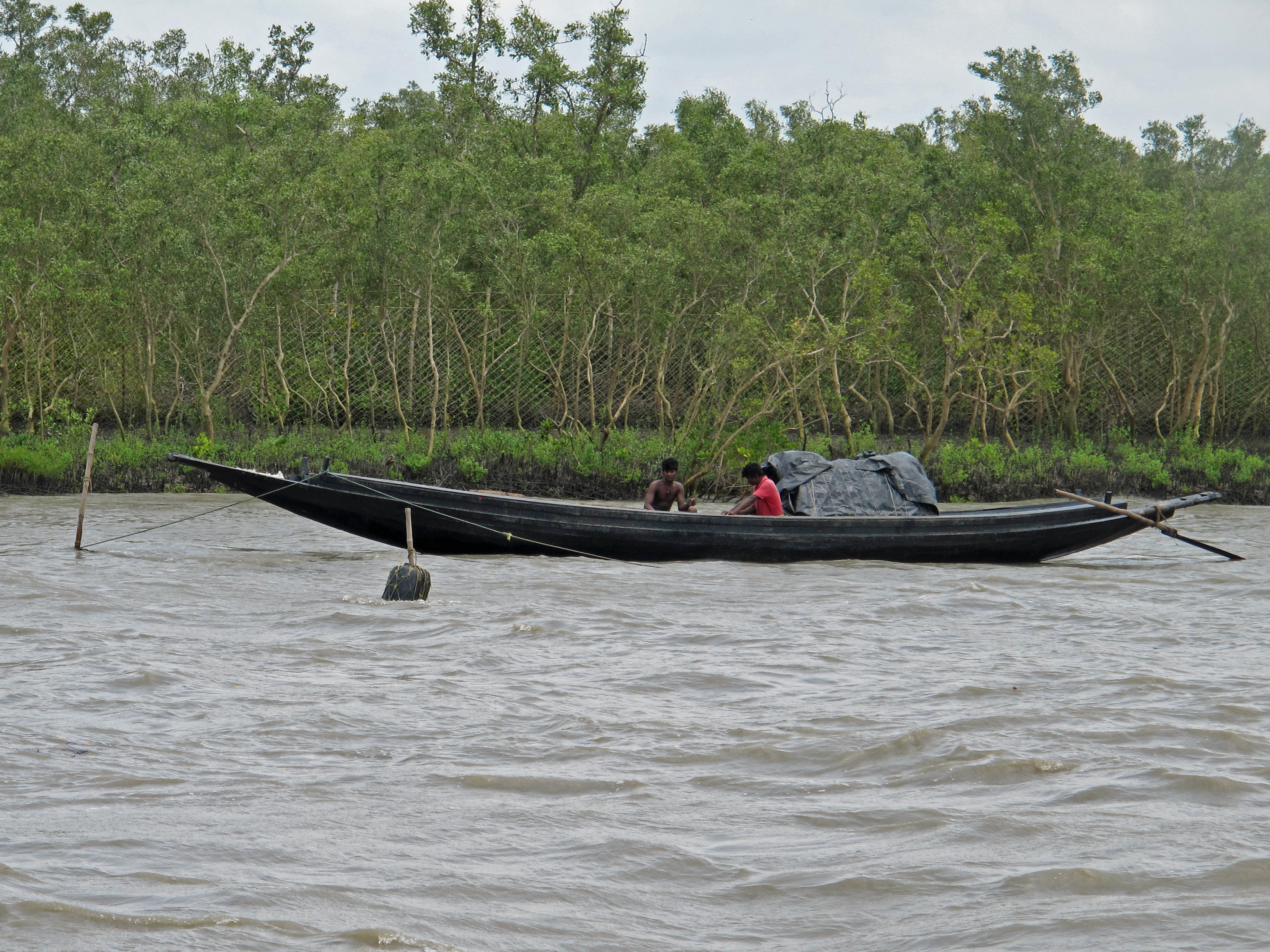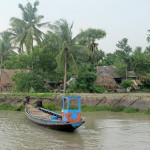
Our guide was limping around the boat, and painfully mounting steps at the pier. A few days before while doing his job, he had slipped on some mossy, muddy bricks – a norm during the rains -, but he gamely pushed on with us. We were glad he did too, as he knew the waters of the Sunderbans delta well – its people and animals – after having lived here his whole life.
As a young boy he would go fishing with his father and his uncle, learning how to navigate the complex waterways and find the fish or crab that provided their livelihood. It’s a unique environment, a huge tangle of rivers and tributaries that all end eventually by spilling into the Bay of Bengal. At 10,000 square kilometers, it’s the largest estuary space in the world, stretching from the Hooghly River south of Kolkata to the might Ganges east in Bangladesh. And unlike other deltas like the Mississippi or the Nile, it remains relatively unspoiled, with little commercial development.

Along with a wide variety of animal life, over forty species of mangroves thrive here, the only type of plant suited to this environment because its cellular structure filters salt from the water, Similarly, animals must be able to accommodate the shifting degrees of salinity that define the delta – as well as the unusual effects of the tides.
That adaptability applies to humans too, whose imprints are not invisible. At the end of the road from Kolkata, after dozens of kilometers of bright green rice fields and occasional market centers, you reach the main waterways of the delta. A small number of shallow-drafting ferries and double-decked tourist boats dot the main passages, mixing with slim long boats used by the villagers for fishing. Roofs thatched with palm atop red-fired brick or hardened mud structures peek over the tall mud embankments. Farther south, villages and their embankments become sparse; village boats vanish into the huge space, as the land becomes virtually uninhabitable.
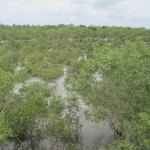
For these embankments are what makes living here possible for people. What passes for land – naturally, often just muddy islands – appears and disappears, grows and shrinks continually with the flow of the salt water tides upriver. The shifting water levels at the embankments are astonishing. At high tide, you can sit in a boat floating near the top of the embankment and see down into most of a village and far across the rice fields; at low tide, there’s a great wall of mud in your way, so you may only see the thatched peaks of the homes.
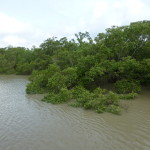
Elsewhere, as you go south toward the Bay of Bengal away from the embankments, the tidal changes transform the landscape. At high tide, small channels swell into navigable rivers and the mangroves appear to be floating on the water. No land is visible.
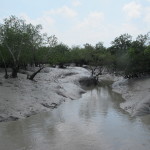
At low tide, contours and crevices of gleaming mud appear, a varied and fascinating topography revealing a myriad of root systems specialized for each type of mangrove. The exposed muddy banks look like an unshaven face, full of stubbly spikes from one of the most prevalent types.
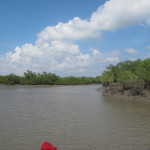
It’s a tough world for animals as well as humans. Estuarine crocodiles and turtles, monitor water lizards, some really big snakes, otters, dolphins, snails, and various other crustaceans and molluscs can thrive. These occupy the salty water, or the mud underwater, and feed within it.
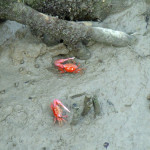
Hundred of species of birds stay or visit during the year. They find plenty of space on the trees to hang out, though the shore birds often settle on low branches waiting for land to reappear. Strangely, in some spots, wild boar, macaque monkeys and spotted deer hold their own, retreating to high ground when necessary. Bees, who make a specially savory honey that some villagers harvest to sell, hover around their hives or flowering trees.
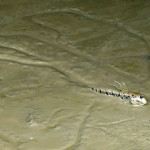
But then there are the Royal Bengal tigers.
Having grown up in the villages of the Sunderbans, our limping guide was quite knowledgeable about most of this wildlife. And he was particularly familiar with the tiger. At age 5, while fishing in the mangrove forest with his uncle, a tiger suddenly attacked from the water. Like all animals that survive here, the tigers are great swimmers, and they can quickly climb into a shallow fishing boat.
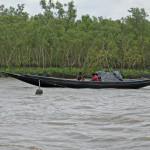
Many fishermen have been attacked and killed while fishing or when nestling at night in their triangular lean-tos at the back of the boat. On the day we arrived, another was killed, and the day before as well. One local said that every villager is familiar with a victim of the “man eating tigers.”

Villagers even revere a goddess called Bonabibi as a protectress against the tigers, with elaborate or makeshift shrines on the islands, as well as with theatrical retellings of her victory over the tiger-demon, Dakkhin Rai. Yet the entire area is home to just 600 tigers in total, a number that has grown since the delta became protected space.
No one is really certain why the tigers go after people here, but typically not in other areas where they prowl near villages. Our guide said that the healthy, capable tigers don’t hunt people; they prefer the meatier, but harder to catch deer, boar, etc. It’s the older, sicker cats that opt for the low hanging fruit of humans. Others think that they have no fear of humans here because they have never been hunted.
But none of that mattered when the tiger attacked his boat. His uncle protected him with his body, while the boy tried to chase the tiger away with a paddle and knife. He succeeded in driving it back into the mangrove forest, but his uncle died from the attack anyway.
By the mid-70s, when this area was designated a protected nature reserve, he was already an expert on the delta and its wildlife. The creation of the reserve started to bring in tourists, expectant with tales of the man-eating tigers and perhaps also with the beauty that shines at all times. The elegant inns that developed here have given the villagers a livelihood beyond the laborious harvesting of the waters.
When he was 18, as a result, the head ranger suggested he become a guide. He demurred, explaining that he had little education and no English. The ranger persisted and he’s now been capably guiding here for nearly 25 years. He’s even appeared in a variety of documentaries about the Sunderbans and been consulted by numerous researchers. As we looked for birds on our boat safaris, and despite his banged up knee, he hustled around the deck to view some bird, often demonstrating his know-how.
And he had survived a Royal Bengal’s attack.
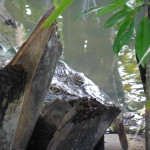
Despite – or perhaps really because of – their notoriety, tigers do appear to be the big draw for tourists here, though the elusive crocodiles have some attraction. All the places to stay have tiger in their name, and the promotional materials share a wildly optimistic tone about seeing one.
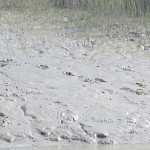
But they shouldn’t be the main attraction. Even our expert guide could not conjure up a tiger for us. Sightings other than by victims are rare; the last sighting was around a month before we arrived. We were lucky at least to see traces, tracks by two different tigers that crossed a creek and walked up the muddy banks left by the ebbing tide, less than an hour before we were there. That, we did agree, was pretty exciting.
The attraction, as it proved for us, should be the serene beauty of the ever-shifting landscape. Long excursions along the waterways reveal their treasures quietly and slowly. Every so often you spot a monitor lizard wriggling up a bank, a kingfisher swooping across a channel, a herd of deer at a fresh water reservoir. This is a place to relax into, and connect with the archetypal cycles of tidal ebb and flow.
(Also, for more pictures from India, CLICK HERE to view the slideshow at the end of the India itinerary page.)


